 |
 |
 |
| |
The impact of direct acting antiviral treatments on all-cause, liver- and drug-related mortality in a large population-based cohort study
|
| |
| |
AASLD 2020 Nov 11-16
Reported by Jules Levin
Janjua NZ 1,2, Wong S 1, Abdia Y 1,2, Bartlett S 1,3, Butt ZA 1, Wilton J 1, Adu PA 1, 2, Samji H 1,4, Pearce ME 1,2, Yu A 1, Jeong D 1,2, Velásquez García H 1, Buller-Taylor T 1, Alvarez M 1, Binka M 1, Krajden M 1,3, The BC Hepatitis Testers Cohort Team
All cause mortality reduced by 70% & liver related mortality reduced by 66% but - Drug related mortality is only reduced by 43% while all cause mortality is reduced by 70%, that's almost 2-fold higher death rate for IDUs....."Drug related mortality is indirect effect of HCV treatment. Hypothesis is treatment improves engagement with care, which could have also accompanied addiction care. Engagement with care could also provide additional social support and stability. All of these factors may help in reducing drug related mortality. 43% reduction in drug related mortality looks good."
Conclusion: DAA treatment substantially reduced all-cause and liver related mortality; however, there was 43% reduced drug-related mortality, which continues to increase globally. These results indicate the urgency of responding to concurrent health/social needs among people who use substances to achieve the full benefit of DAAs in improving health and achieving WHO elimination goals.
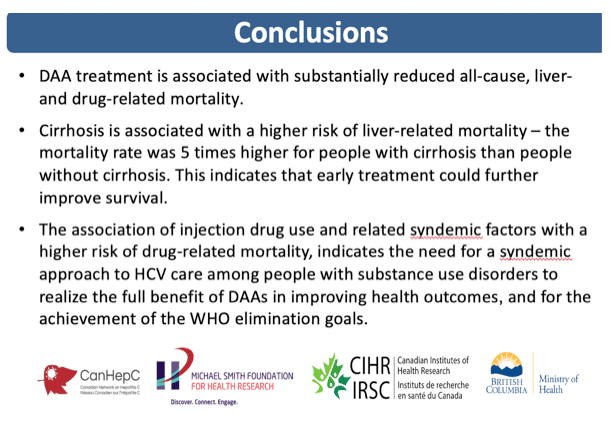
Abstract
Background: We evaluated the effect of direct acting antiviral (DAA) treatments on all-cause, liver and drug-related mortality in a large population-based cohort in British Columbia (BC), Canada.
Methods: We used data from the BC Hepatitis Testers Cohort, which includes ~1 .3 million people tested for hepatitis C virus (HCV) since 1990, linked with data on medical visits, hospitalizations, prescription drugs and mortality . Patients who received DAAs were matched on propensity scores of DAA receipt with those who were untreated, then followed to death or June 30, 2019 . We performed multivariable proportional hazard modeling to assess effect of DAAs on all-cause, liver and drug-related mortality.
Results: Of 10,602 people treated with DAAs, 9,682 were matched to untreated people and followed for a median [IQR] of 2 .6 [range:1 .4-3 .8] and 11 .9 [range:7 .7-15 .3] years, respectively . Of those treated and matched, 9,208/9,682 (95%) achieved SVR . The all- cause mortality rate was 18 .5/1000 person-years (PY) among SVR group, 118 .0/1000 PY among non-SVR group, and 22 .4/1000 PY among untreated group . Drug-related mortality rates among SVR, non-SVR and untreated groups were 4 .4, 12 .8 and 4 .4/1000 PY, respectively . In the multivariable model, SVR was associated with significant reduction in all- cause (adjusted hazard ratio (aHR) = 0 .45, 95%CI: 0 .39- 0 .52) and liver related mortality (subdistribution HR (asHR) = 0 .4, 95%CI: 0 .31-0 .53) compared to no treatment. However, SVR was not associated with reduced drug-related mortality [asHR=1 .33, 95%CI: 1 .0-1 .77] . Factors associated with higher risk of drug-related mortality included injection drug use (asHR=2 .47, 95%CI: 1 .96-3 .11), problematic alcohol use (asHR=1 .63, 95%CI: 1 .35-1 .96), mental illness (asHR=1 .37, 95%CI: 1 .13-1 .66), HIV (asHR=2 .04, 95%CI: 1 .63-2 .56) and HBV (asHR=1 .36, 95%CI: 1 .01-1 .82) co-infections . Results were same when follow-up time for untreated started at the approval date for DAAs.
Conclusion: DAA treatment substantially reduced all-cause and liver related mortality; however, there was no impact on drug-related mortality, which continues to increase globally. These results indicate the urgency of responding to concurrent health/social needs among people who use substances to achieve the full benefit of DAAs in improving health and achieving WHO elimination goals .
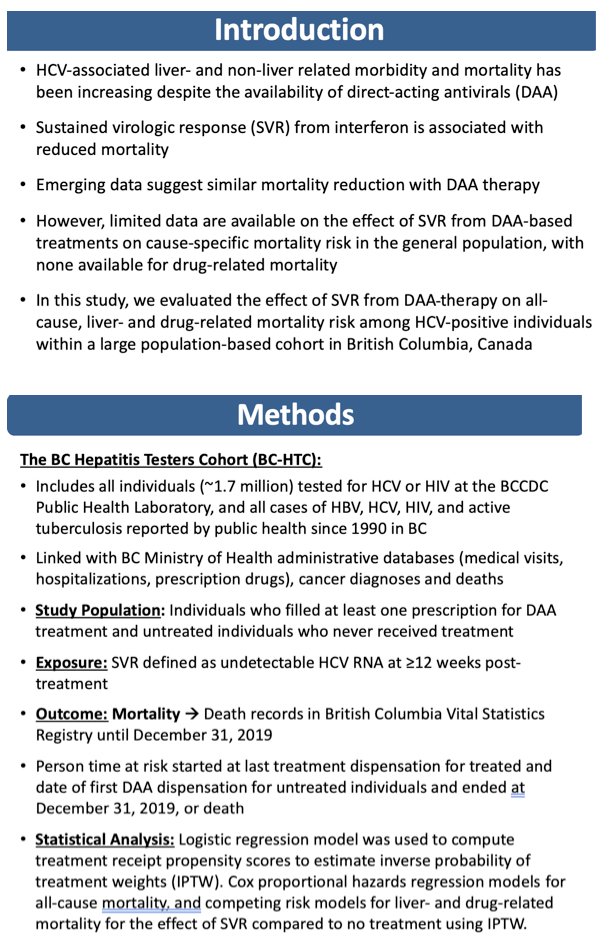
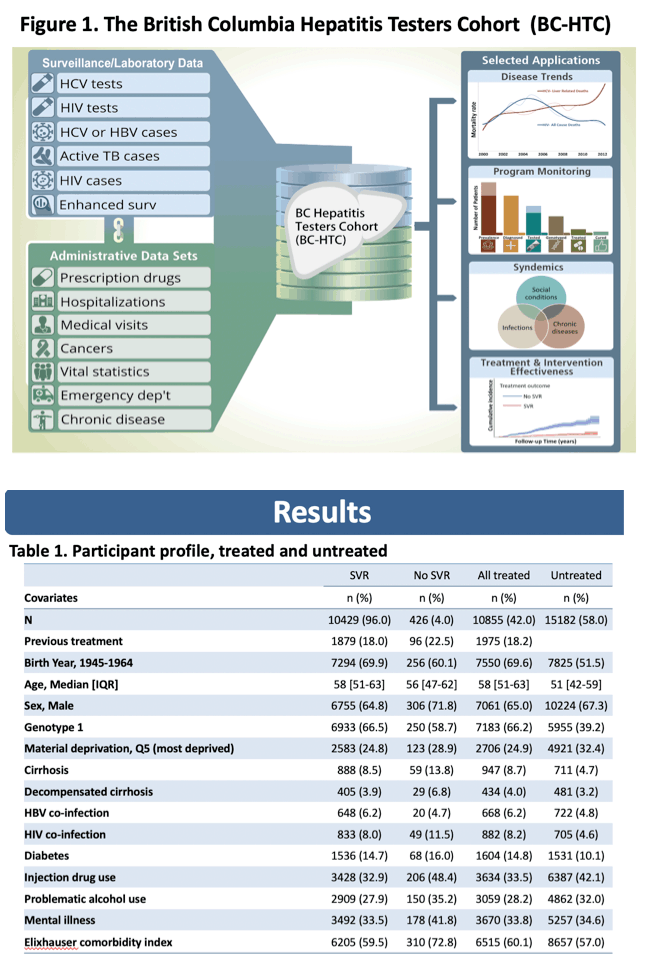
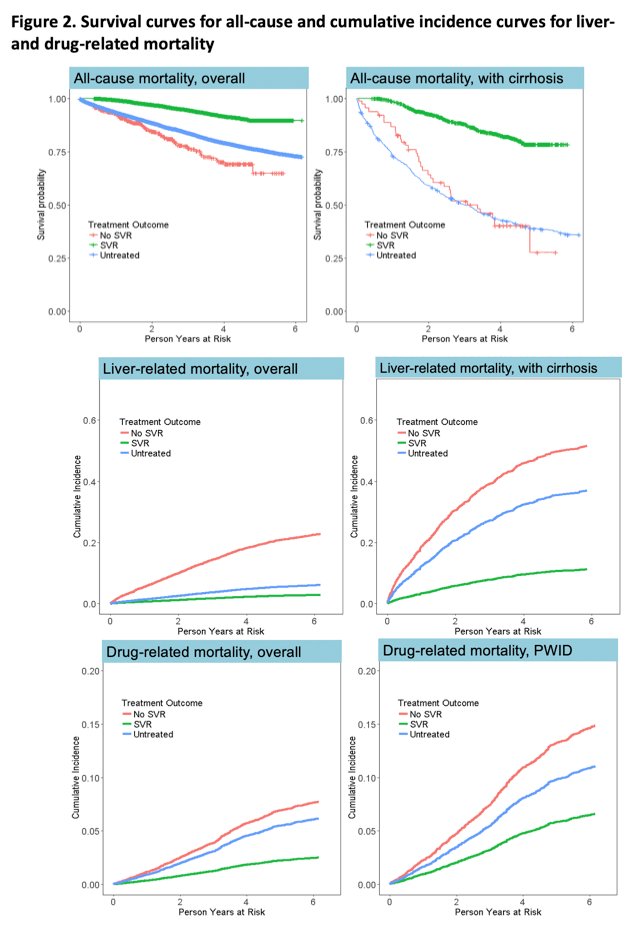
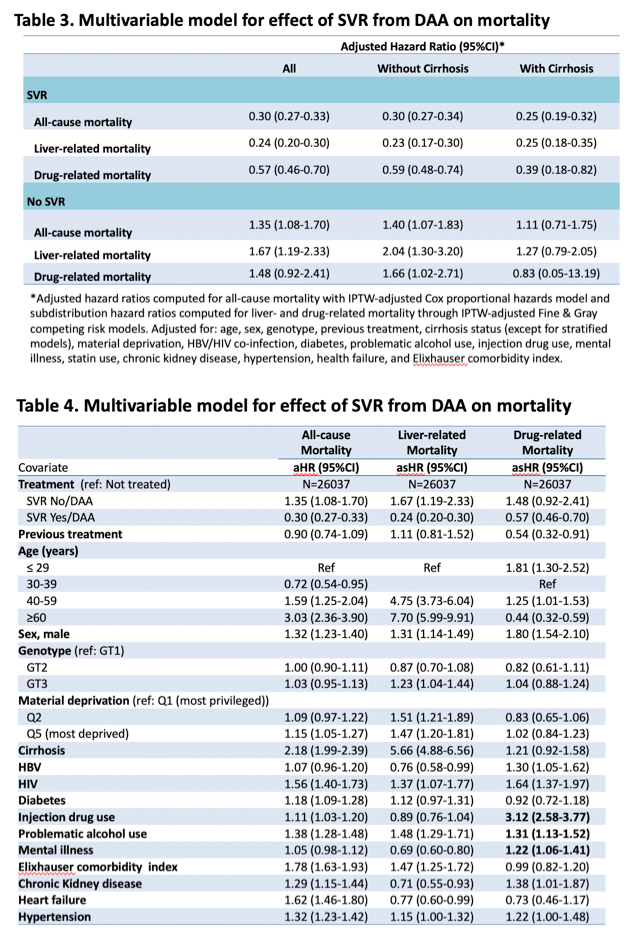

|
| |
|
 |
 |
|
|